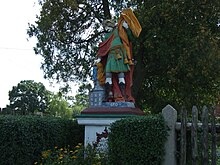Bycina
| Bycina Bitschin |
||
|---|---|---|
 Help on coat of arms |
|
|
| Basic data | ||
| State : | Poland | |
| Voivodeship : | Silesia | |
| Powiat : | Gliwicki (Gleiwitz) | |
| Gmina : | Rudziniec (Rudzinitz) | |
| Geographic location : | 50 ° 23 ' N , 18 ° 32' E | |
| Residents : | 1002 (2018) | |
| Postal code : | 44-120 | |
| Telephone code : | (+48) 032 | |
| License plate : | SGL | |
| Economy and Transport | ||
| Next international airport : | Katowice-Pyrzowice | |
Bycina (German Bitschin ) is a place in Upper Silesia . It is located in the municipality of Rudziniec (Rudzinitz) in the powiat Gliwicki (district of Gliwice) in the Silesian Voivodeship .
history
The place originated in the 13th century at the latest and was first mentioned in a document in 1263. At that time the village was owned by the noble Liebsteinsky-Kolowrat family. In 1676 Bitschin came into the possession of the Colonna family. Shortly afterwards, Count Paczensky von Tenczin bought it. The castle was completed in 1700.
The place was mentioned in 1783 in the book Additions to the description of Silesia as Bitschin and Biczywa , belonged to a Lord von Strachiwtz and was in the Tost district of the Principality of Opole . At that time he had 139 inhabitants, a Vorwerk , a school, a blast furnace, ten farmers and 23 gardeners . In 1865 Bitschin consisted of an estate and a village. At that time, the place had eight farm jobs, 18 gardener jobs and 29 cottage jobs, as well as a Catholic school with 263 students from Bitschin, Tatischau and Ciochowitz, a Kretscham (restaurant) and a stately head forester's office. Trieste also points to a hill with a brick wayside shrine in the gardener's courtyard, which was filled with human bones. This is said to be the burial place of those killed in the Seven Years' War who met in the village. In 1805 the nearby Klodnitz Canal was opened.
In the referendum in Upper Silesia on March 20, 1921, 239 voters locally voted for Upper Silesia to remain with Germany and 286 for membership in Poland. Bitschin remained with the German Empire after the division of Upper Silesia . In 1936, the city in the wake of a wave of local renaming was the Nazi era in Fichtenrode renamed. In 1939 the Gliwice Canal was opened. Until 1945 the place was in the district of Tost-Gleiwitz .
In 1945 the until then German place came under Polish administration and was then attached to the Silesian Voivodeship and renamed the Polish Bycina . 1950 the place came to the Voivodeship Katowice. In 1999 the place came to the re-established Powiat Gliwicki and the Silesian Voivodeship. In 2000 the new church was consecrated.
Buildings and monuments
- The ruins of the late baroque castle , the construction of which was started at the end of the 17th century by Count Albert Leopold Paczensky von Tenczin and completed in 1700. Reconstruction after a fire in 1867. The castle has been renovated since 2001 and the work has not yet been completed. The inscription “Albertus Leopold: Comes a Tencin ann. D. 1700. "
- The modern Roman Catholic Trinity Church, built in the 1990s
- Sculpture of St. Florian from 1787, renovated in 1906. Painted in colors.
- The Nepomuk Chapel, path chapel from 1794, renovated in 1936 and 2013. There is an ornate metal fence around the chapel with the coats of arms of Bitschin and Upper Silesia on the gate.
coat of arms
The coat of arms shows a spruce on a mound clearing the trunk with an ax. Thus, in relation to the name Fichtenrode, it is a Redendes coat of arms . Old seals and stamps of the place show the eye of providence in a triangle, which refers to the Trinity. Thus this coat of arms could be related to the castle chapel, which is consecrated to the Holy Trinity (Trinity).
Web links
Individual evidence
- ↑ About the place
- ↑ Friedrich Albert Zimmermann: Additions to the Description of Silesia , Volume 2 , Brieg 1783
- ↑ Felix Triest : Topographisches Handbuch von Oberschlesien , Breslau 1865
- ^ Results of the referendum in Upper Silesia in 1921: Literature , table in digital form





